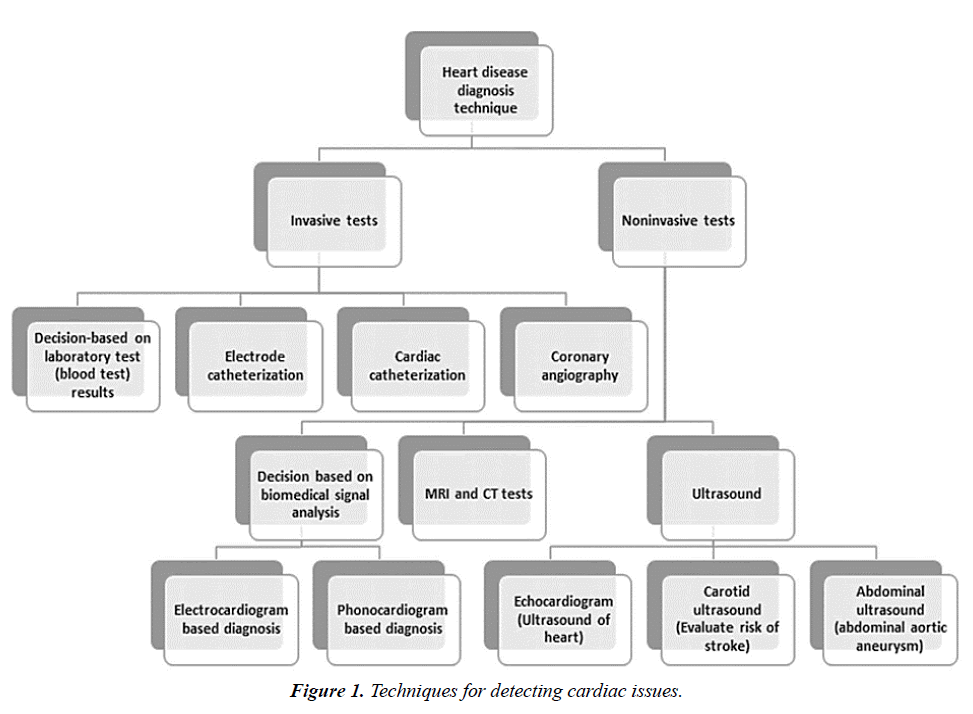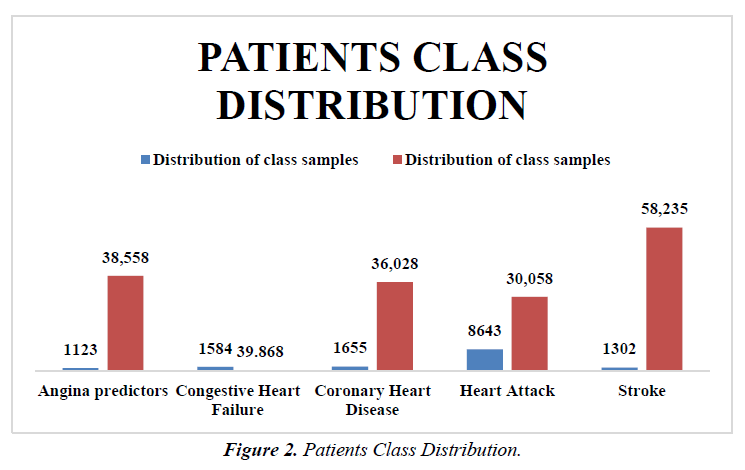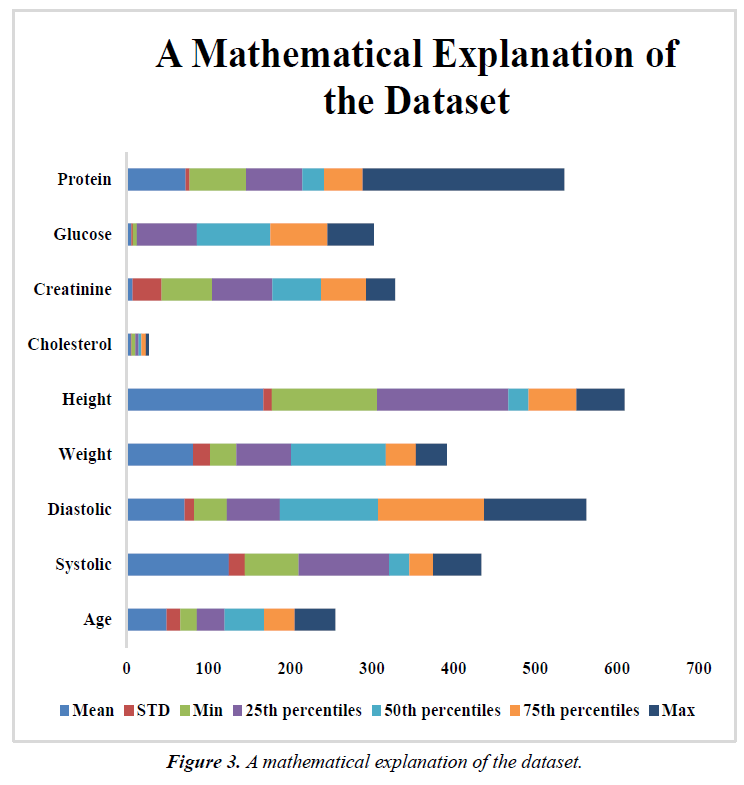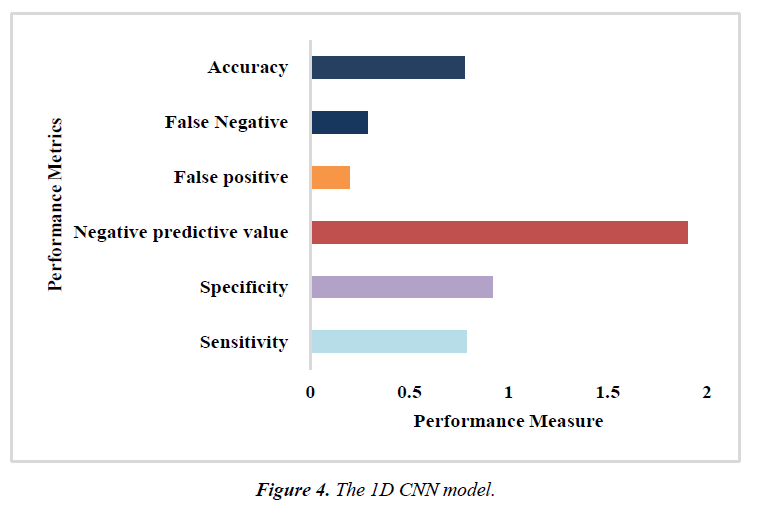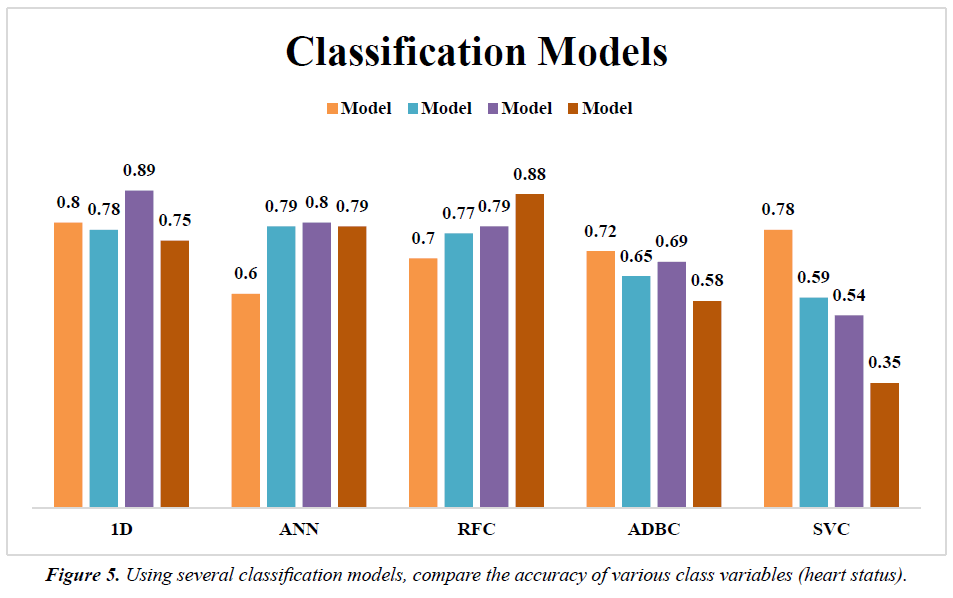Research Article - Journal of Nutrition and Human Health (2023) Volume 7, Issue 5
Artificial Intelligence and Nanotechnology for Diagnosis of Heart Disease
Shaikh Abdul Hannan*Department of CS & IT, AlBaha University, AlBaha, Kingdom of Saudi Arabia
- *Corresponding Author:
- Shaikh Abdul Hannan
Department of CS & IT, AlBaha University
AlBaha, Kingdom of Saudi Arabia
E-mail: ahannanbu@gmail.com
Received: 11-Sep-2023, Manuscript No. AAJNHH-23-113312; Editor assigned: 13-Sep-2023, Pre QC No. AAJNHH-23-113312(PQ); Reviewed: 27-Sep-2023, QC No. AAJNHH-23-113312; Revised: 29-Sep-2023, Manuscript No. AAJNHH-23-113312(R); Published: 06- Oct -2023, DOI: 10.35841/aajnhh-7.5.166
Citation: Hannan AS. Artificial intelligence and nanotechnology for diagnosis of heart disease. J Nutr Hum Health.2023;7(5):166
Abstract
Early identification is critical for effective prevention and treatment of heart disease, which is a substantial health care concern. Traditional and non-invasive methods are time-consuming, uncomfortable, costly, and unsuited for periodic examination or diagnosis. There are numerous Non-Invasive (NI) approaches for diagnosing CVD. Data obtained by NI methods is primarily of three forms: (i) information derived from clinical variables, lab tests, and signs and symptoms (ii) raw cardiovascular data (ECG and PCG); or (iii) cardiac images. Three unique ML (machine learning) frameworks may be constructed based on the three types of data. Non-coronary cardiovascular illness (no-CHD) and myocardial cardiovascular disease (CHD) test findings were 80.1% and 76.9% accurate, respectively. SVM (Support Vector Machines) and artificial neural networks (Artificial Neural Network) were found to perform better in the majority of studies across all platforms. Deep neural networks are a relatively recent artificial intelligence technology that is producing impressive results in categorizing heart sounds and cardiovascular imaging. The current work will aid in the automation of the detection of cardiovascular disease by offering recommendations and possibilities for fresh researchers in the field of machine learning.
Keywords
Heart disease, Artificial intelligence, Machine learning, Non-invasive methods, Feature extraction.
Introduction
Cardiovascular Diseases (CVDs) and stroke are the main causes of death globally. The World Health Organization (WHO) has reported that seventeen million individuals died from CVDs in 2015, which equates to 31% of all worldwide mortality. Roughly 7.4 million of this mortality was triggered by coronary heart disease, with stroke accounting for the remaining 6.7 million [1]. Early and timely diagnosis is crucial for good CVD and stroke outcomes.
According to a recent study, 17.9 million individuals worldwide die each year as a result of cardiac disease. Using this data as a raw figure, one might estimate that around 49000 individuals die every day owing to cardiac problems globally, which is a large amount [2]. Death rates from heart disease are higher in poor and undeveloped countries due to the high cost of diagnosis.
The majority of fatalities caused by various CVDs are caused by heart failure (CAD). CAD occurs as a result of the creation of a material known as atherosclerotic plaque, which limits the blood flow to the heart, resulting in a heart attack known clinically as a Myocardial Infarction (MI) [3].
As a result, some clinical measurement is essential to detect the initial development of atherosclerotic plaque, and the formation must be prevented with some defined medical therapy (Figure 1) [4]. The diagnosis of cardiac disease can be accomplished in two ways:
(i) Invasive methods or
(ii) Non-invasive methods
Researchers have been trying to resolve difficulties associated with traditional non-invasive methods of identifying cardiac conditions by combining advances in Artificial Intelligence (AI) and Deep Learning (DL) with simple to obtain health indicators such as an ECG (electrocardiogram) [5], the Picture Ultrasound Energy (PPG), Phonocardiogram (PCG), and others.
The majority of fatalities caused by various CVDs are caused by heart disease (CAD). CAD occurs as a result of the creation of a material known as atherosclerotic plaque, which limits the blood flow to the heart, As a result, a heart attack called professionally as myocardial infarction, or MI for short, occurs.
As a result, it is critical to diagnose the early phases of atherosclerotic plaque formation using clinical assessment and to prevent its formation using appropriate medical therapy [6]. Diagnosis of cardiac disease can be performed using either invasive or non-invasive approaches. Coronary imaging (CA) is a surgical method that is widely used to diagnose heart problems.
This study presents a complete and extensive analysis of several research that employed machine learning technology to diagnose cardiac issues. According to the studies assessed, Non-Invasive (NI) modalities are used to train Artificial Intelligence (AI) models [7].
Objectives
• The following section involves discusses multiple sources of data for cardiac ailments.
• Recent research shows that machine learning approaches have made a significant contribution to the computerized detection of cardiac disease.
Literature Review
Vashistha R, Dangi (2018) The future of heart health care will be shaped by technologies based on biosensors, which are at the forefront of current medical applications. For point-ofcare (POC) diagnostics, the use of biosensors based on cardiac monitoring and Artificial Intelligence (AI) is highlighted here [8].
Jakupovic A, Kovacevic (2018) Nanotechnology has demonstrated tremendous promise in a variety of scientific sectors, including medicine and pharmacy. Based on information acquired from several studies, this study provides an overview of artificial neural networks utilized in nanotechnology. It is critical to understand artificial neural network applications so that they may be used more effectively in future applications [9].
Johnson K W (2018) The use of AI and algorithms for learning are set to have an impact on practically every facet of the human experience, and cardiac is no different. This study examines selected implementations of AI and machine learning in cardiology to date, provides a clinical guide to important aspects of these fields, and suggests ways that artificial learning might be incorporated into cardiovascular medicine in the future [10].
Huchegowda R (2019) Artificial intelligence (AI) will have a significant impact on our daily lives. AI is changing the way we live and interact experience the world, yet there is plenty more to come in the decades ahead as technology advances. As artificial intelligence becomes more completely interwoven into our daily routines, it will develop into an infrastructure that will fuel a second industrialization [11].
ChavanPatil A B &Sonawane P (2017) The most fatal disease in today's contemporary world is cardiovascular disease. This sickness strikes a person so quickly that there is little time to treat it. As a result, the most difficult responsibility for the medical profession is appropriately diagnosing patients on a timely basis. A hospital's incorrect diagnosis results in a negative name and a loss of repute. The goal of this project is to provide a low-cost therapy employing data mining methods for enabling storing data decision support systems [12].
Junejo A R Shen X & Luo H (2019) With the advancement of industry and a more automated lifestyle, the disease's incidence is constantly increasing. According to the history and lifetime style, it is predicted that after ten years, about 23.6 million individuals would die as a result of coronary artery disease (CVD). As a result, the goal is to apply deep learning methods (DLTs) to analyse stable CVD, which will provide vital information to reduce misinterpretation in the Resilient Healthcare Sector (RHI) [13].
Hassanzadeh P Atyabi (2019) Over the course of the past ten years, there has been a flood of interest in the utilization of man-made consciousness ( simulated intelligence ) for breaking down and deciphering natural or hereditary information, speeding up drug revelation, and recognizing specific little particle specialists or uncommon atoms and anticipating their way of behaving [14].
Chocholova E &Tkac J (2018) A total of one hundred samples of serum from healthy persons and individuals with arthritis caused by rheumatism (RA) were analysed in this study. For each serum sample, standard allergy tests for detection of 10 distinct RA indicators and analysis of glycan markers on antibody in 10 different assay formats with various lectins were used. Data mining was performed on a dataset comprising 2000 data points using neural networks made up of neurons (ANN) [15].
Roski, J Hamilton & Pierce J (2019) Early AI robotics applications included industrial production, autopilots and autonomous cars, and residential robots like the Roomba, with more studies focused on human and canine-like machines. Developing four-legged machines move around or recover form falls has proven particularly difficult [16].
Yahyaie M, Tarokh M (2019) Background The majority of research on coronary artery disease prediction has used an offline decision-making technique. As a novel idea in the world of information technology, the Internet of Things (IoT) allows this to happen online. The purpose of this study was for searching at an Internet of Things (I approach to predicting heart attacks. In this concept, electrocardiogram (ECG) data is used in real time to aid decision-making. Methods: A study model was created to collect emergency cardiac data in the present [17, 18].
Materials and Methods
Artificial intelligence approaches used in heart disease diagnostics
This section discusses numerous machine learning models and methodologies as well as distinct frameworks. Innovative approaches and processes are explained and contrasted for each Framework. Before going into the mechanics of each strategy, a high-level overview of AI is provided [19]. There are four types of machine learning: supervised, unsupervised, learning through reinforcement, and active learning.
Each data documentation comprises an exhaustive description of the qualifying sample, technique and procedure, information handling and editing, data storage and retrieval, as well as information storage and retrieval. The NHANES, in contrast to the other datasets used in recent research articles, is an extremely structured and organized collection of data that may be used to identify cardiac illness [20]. Table 1 displays the distribution of patient classifications (Figure 2).
| Distribution of class samples | ||
|---|---|---|
| Negative | Positive | |
| Angina predictors | 1123 | 38,558 |
| Congestive Heart Failure | 1584 | 39.868 |
| Coronary Heart Disease | 1655 | 36,028 |
| Heart Attack | 8643 | 30,058 |
| Stroke | 1302 | 58,235 |
Table 1. Patients Class Distribution
The prediction is evaluated using a performance metric (P) in such a way that the error (Err) reduces across all training sets during training and across every testing samples during testing [21].
 (1)
(1)
Analysis
This section goes over the full data review process for the intended research. The section continues with how the unbalance problem was solved and the raw data preparation for feature optimization [22]. The following sections list the qualities that were rated or selected after using feature selection methods. Following that, the 1D CNN structure used to train a machine learning model in terms of layer data is discussed, including the usage of hyper parameter tuning.
Imbalanced Data and Exploratory Investigation
The dataset was produced for feature augmentation or selection after the NHANES, or data for the arteries of the heart health (CHD) class unclear was organized and accumulated. When evaluating every detail in the data set, the imbalance of the dataset stands obvious. In terms of class variables, the total amount of non-CHD patients much exceeds the number of CHD patients [23]. Table 2 offers an example of the mathematical explanation of a data collection using one of the qualities as an example (Figure 3).
| Parameter | Age | Systolic | Diastolic | Weight | Height | Cholesterol | Creatinine | Glucose | Protein |
|---|---|---|---|---|---|---|---|---|---|
| Mean | 48.99 | 125.18 | 71 | 81.25 | 167.34 | 5.06 | 7.36 | 5.69 | 72 |
| STD | 16.88 | 19.15 | 11.71 | 20.85 | 10.13 | 1.09 | 35.36 | 2.06 | 4.89 |
| Min | 20 | 66 | 40 | 32.29 | 128.8 | 4.29 | 61.86 | 4.72 | 69.08 |
| 25th percentiles | 34 | 110.65 | 64.5 | 66.9 | 160.69 | 4.29 | 73.66 | 73.29 | 69 |
| 50th percentiles | 48.56 | 24.99 | 120.26 | 115.69 | 24.59 | 2.99 | 59.65 | 89.99 | 26.69 |
| 75th percentiles | 36.99 | 28.99 | 129.9 | 36.98 | 58.56 | 5.69 | 54.99 | 69.78 | 46.99 |
| Max | 49.69 | 58.96 | 124.96 | 37.59 | 58.99 | 3.65 | 35.69 | 56.99 | 246.9 |
Table 2. A mathematical explanation of the dataset, including some examples of characteristics
 (2)
(2)
 (3)
(3)
Results
Study population
This section discusses the results of the data analysis stage. The results of the investigation of the 1D CNN architecture model [24] are presented first, followed by an analysis of alternative models. (Figure 4) illustrates that, despite a significant imbalance in the data set, the addition of 1D CNN resulted in improved accuracy. On four sets of data (congestive coronary artery disease, ischemic stroke, angina pectoris (chest pain), and heart attack), Table 3 and (Figure 5) compare the proposed 1D CNN to different current machine learning (ML) algorithms such as neural network models (ANN RFC, ADBC, SVC, and others). Using Keras, an artificial neural network, or ANN, with three hidden layers (64, 128, and 256 units) was formed during the training approach [25].
| Model | ||||
|---|---|---|---|---|
| Accuracy | Congestive Heart Failure | Stroke | Angina Pectoris | Heart Attack |
| 1D | 0.8 | 0.78 | 0.89 | 0.75 |
| ANN | 0.6 | 0.79 | 0.8 | 0.79 |
| RFC | 0.7 | 0.77 | 0.79 | 0.88 |
| ADBC | 0.72 | 0.65 | 0.69 | 0.58 |
| SVC | 0.78 | 0.59 | 0.54 | 0.35 |
Table 3. Using several classification models, compare the accuracy of various class variables (heart status)
Discussion
The datasets employed in virtually all of the research for recognizing signs of cardiovascular illness using neural networks were modest [26]. Because some of the characteristics within those restricted numbers required to be more relevant, they were not constructed with the intention of being used for machine learning. That is why presenting a dataset with numerous important attributes and a considerably larger number of data points was critical.
Strategies based on machine learning have made significant contributions to the automated detection of cardiac disease, as seen by the recent works reviewed and emphasized in this paper [27]. Deep neural networks are effective for PCG analysis and cardiovascular imaging categorization. Despite the availability of numerous data repositories and machine learning methods for heart disease detection, accuracy and other performance indicators can always be improved.
The study included various limitations and limits. Although the amount of features provided in this study has been not only greater than in previous studies, but the characteristics were also more pertinent and the model would have been better trained if additional information was available [28].
This is because of the way that discovery doesn't depend on a solitary trademark, for example, cardiovascular arrhythmia while conclusion depends on the aggregate sum of heart beats each moment [29]. The cardiac disorders examined in this study have become more complex, with symptoms and outcomes dispersed across numerous body parts and features, such as stroke, which begins with a constriction of blood vessels caused by hypertension or a rupture of stream vessels in the cerebral cortex [30].
Conclusion
Heart disease is a lethal chronic condition that is extremely difficult to treat if identified at an advanced stage. On each other hand, if detected early, correct treatment can be provided. In reality, in certain circumstances, changing one's lifestyle might enhance one's health. Early identification also has a beneficial financial impact on the patient's family as opposed to later detection. This study indicates that a larger dataset, a group feature selection technique, and a modified 1D CNN be utilized to classify clinical characteristics into different types of heart disease. All sorts of data used to forecast coronary artery disease are subjected to a quick but informative evaluation. The most recent supervised machine learning algorithms for heart disease detection are compiled. The values where several ML algorithms performed similarly proved to be onesided. Higher performance in those circumstances resulted from greater involvement from the vast majority of the class (non-CHD).
Future Works
Work will be done in the future to address or alleviate those shortcomings, making the model reliable and effective for all heart health problems.
References
- Qureshi A, Gurbuz Y, Kallempudi S, et al. Label-free RNA aptamer-based capacitive biosensor for the detection of C-reactive protein. Phys Chem Chem Phys. 2010;12(32):9176-82.
- Chen HL, Yang B, Wang G, et al. Support vector machine based diagnostic system for breast cancer using swarm intelligence. J Med Syst. 2012;36:2505-19.
- Weng SF, Reps J, Kai J, et al. Can machine-learning improve cardiovascular risk prediction using routine clinical data?. PLoS One. 2017;12(4):e0174944.
- Nai-Arun N, Moungmai R. Comparison of classifiers for the risk of diabetes prediction. Procedia Comput Sci. 2015;69:132-42.
- Hariharan M, Polat K, Sindhu R. A new hybrid intelligent system for accurate detection of Parkinson's disease. Comput Methods Programs Biomed. 2014;113(3):904-13.
- Alizadehsani R, Roshanzamir M, Abdar M, et al. A database for using machine learning and data mining techniques for coronary artery disease diagnosis. Sci Data. 2019;6(1):227.
- Khan Mamun MM, Sherif A. Advancement in the Cuffless and Noninvasive Measurement of Blood Pressure: A Review of the Literature and Open Challenges. Biomed Eng. 2022;10(1):27.
- Vashistha R, Dangi AK, Kumar A, et al. Futuristic biosensors for cardiac health care: an artificial intelligence approach. 3 Biotech. 2018;8:1-1.
- Jakupovic A, Kovacevic Ž, Gurbeta L, et al. Review of artificial neural network application in nanotechnology. MECO 2018. 2018:1-4.
- Johnson KW, Torres Soto J, Glicksberg BS, et al. Artificial intelligence in cardiology. J Am Coll Cardiol. 2018;71(23):2668-79.
- Huchegowda R. Review on artificial intelligence and applications in healthcare. Neuro J. 2019;6:1.
- Chavan Patil AB, Sonawane P. To predict heart disease risk and medications using data mining techniques with an IoT based monitoring system for post-operative heart disease patients. Int J Emerg Trends Eng Technol. 2017;4:8274-81.
- Junejo AR, Shen Y, Laghari AA, et al. Notice of Retraction: Molecular Diagnostic and Using Deep Learning Techniques for Predict Functional Recovery of Patients Treated of Cardiovascular Disease. Int J Emerg Trends Eng Technol. 2019;7:120315-25.
- Hassanzadeh P, Atyabi F, Dinarvand R. The significance of artificial intelligence in drug delivery system design. Adv Drug Deliv Rev. 2019;151:169-90.
- Chocholova E, Bertok T, Jane E, et al. Glycomics meets artificial intelligence–potential of glycan analysis for identification of seropositive and seronegative rheumatoid arthritis patients revealed. Clin Chim Acta. 2018;481:49-55.
- Roski J, Hamilton BA, Chapman W, et al. How artificial intelligence is changing health and health care. Artif Intell Med. 2019:58.
- Yahyaie M, Tarokh MJ, Mahmoodyar MA. Use of internet of things to provide a new model for remote heart attack prediction. Telemed J E Health. 2019;25(6):499-510.
- Gupta A, Kumar R, Arora HS, et al. MIFH: A machine intelligence framework for heart disease diagnosis. Int J Emerg Trends Eng Technol. 2019;8:14659-74.
- Wiharto W, Kusnanto H, Herianto H. Intelligence system for diagnosis level of coronary heart disease with K-star algorithm. Healthc Inform Res. 2016;22(1):30-8.
- Liu N, Lin Z, Cao J, et al. An intelligent scoring system and its application to cardiac arrest prediction. Int J Emerg Trends Eng Technol. 2012;16(6):1324-31.
- Kan G, Visser CA, Koolen JJ, et al. Short and long term predictive value of admission wall motion score in acute myocardial infarction. A cross sectional echocardiographic study of 345 patients. Heart. 1986;56(5):422-7.
- Guvenir HA, Acar B, Demiroz G, et al. A supervised machine learning algorithm for arrhythmia analysis. Comput Cardiol. 1997:433-436.
- Ayres-de-Campos D, Bernardes J, Garrido A, et al. SisPorto 2.0: a program for automated analysis of cardiotocograms. J Matern Fetal Neonatal Med. 2000;9(5):311-8.
- Ahsan MM, Siddique Z. Machine learning-based heart disease diagnosis: A systematic literature review. Artif Intell Med. 2022;128:102289.
- Mamun MM. Cuff-less blood pressure measurement based on hybrid feature selection algorithm and multi-penalty regularized regression technique. Biomed Phys Eng Express. 2021;7(6):065030.
- Kiranyaz S, Ince T, Gabbouj M. Personalized monitoring and advance warning system for cardiac arrhythmias. Sci Rep. 2017;7(1):9270.
- Abdeljaber O, Avci O, Kiranyaz MS, et al. 1-D CNNs for structural damage detection: Verification on a structural health monitoring benchmark data. Neurocomputing. 2018;275:1308-17.
- Gupta A, Kumar R, Arora HS, et al. MIFH: A machine intelligence framework for heart disease diagnosis. Int J Emerg Trends Eng Technol. 2019;8:14659-74.
- Das S, Mishra S, Senapati MR. New approaches in metaheuristic to classify medical data using artificial neural network. Arab J Sci Eng. 2020;45:2459-71.
- Zhou H, Zhang J, Zhou Y, et al. A feature selection algorithm of decision tree based on feature weight. Expert Syst Appl. 2021;164:113842.
Indexed at, Google Scholar, Cross Ref
Indexed at, Google Scholar, Cross Ref
Indexed at, Google Scholar, Cross Ref
Indexed at, Google Scholar, Cross Ref
Indexed at, Google Scholar, Cross Ref
Indexed at, Google Scholar, Cross Ref
Indexed at, Google Scholar, Cross Ref
Indexed at, Google Scholar, Cross Ref
Indexed at, Google Scholar, Cross Ref
Indexed at, Google Scholar, Cross Ref
Indexed at, Google Scholar, Cross Ref
Indexed at, Google Scholar, Cross Ref
Indexed at, Google Scholar, Cross Ref
Indexed at, Google Scholar, Cross Ref
Indexed at, Google Scholar, Cross Ref
Indexed at, Google Scholar, Cross Ref
Indexed at, Google Scholar, Cross Ref
Indexed at, Google Scholar, Cross Ref
